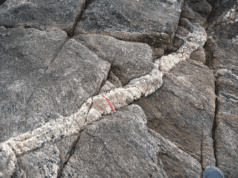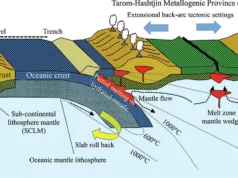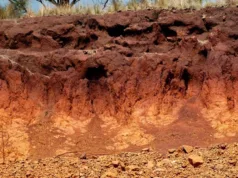Magmatic deposits are mineral deposits that are associated with igneous rocks, such as granite, gabbro, and basalt. They are formed by the cooling and crystallization of magma or lava, which can result in the concentration of various minerals within the solidified rock. Magmatic deposits can be further subdivided into two main types: intrusive and extrusive.
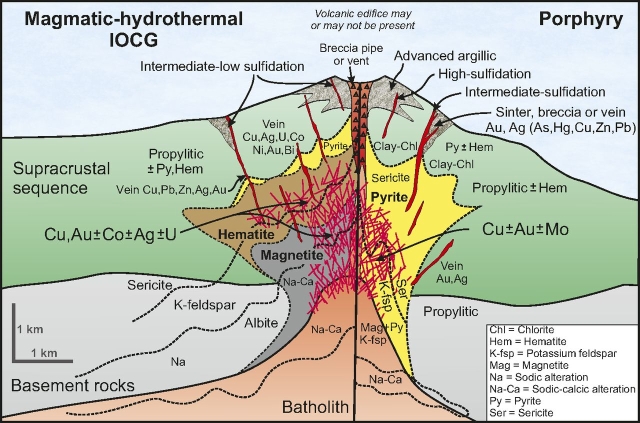
Intrusive magmatic deposits, also known as plutonic deposits, are formed when magma solidifies within the Earth’s crust. As the magma cools, minerals begin to crystallize out of the melt and become concentrated in certain parts of the rock. The resulting deposits can be massive in size and can contain high concentrations of valuable minerals, such as copper, nickel, platinum, and gold.
Extrusive magmatic deposits, also known as volcanic deposits, are formed when magma or lava erupts onto the Earth’s surface and solidifies. These deposits can be found in the form of lava flows, volcanic ash, and other volcanic rocks. Some examples of extrusive magmatic deposits include massive sulfide deposits, which are rich in copper, zinc, and lead, and platinum-group element deposits, which are rich in platinum, palladium, and rhodium.
Magmatic deposits can be economically important sources of various metals and minerals, and they are often the targets of mining and exploration activities.
Types of magmatic deposits
Magmatic deposits are formed from magma, which is molten rock that originates from the Earth’s mantle or lower crust. As the magma cools and solidifies, it can concentrate certain elements, which can form deposits of valuable minerals.
There are several types of magmatic deposits, including:
- Porphyry Deposits: These are the most common type of magmatic deposit and are typically found in copper and gold mining operations. Porphyry deposits form when magma intrudes into the earth’s crust, and minerals are deposited as the magma cools and solidifies. Porphyry deposits are generally low-grade but large-tonnage operations that require significant amounts of processing.
- Skarn Deposits: Skarn deposits are formed by the interaction of magma with carbonate rocks. The heat and fluids from the magma alter the carbonate rocks, creating a zone of mineralization called a skarn. Skarn deposits are known for their high-grade deposits of copper, gold, silver, and tungsten.
- Pegmatite Deposits: These deposits are known for their coarse-grained nature, which makes them easier to mine. Pegmatites are formed from the late-stage cooling of magma and contain a variety of minerals, including rare earth elements, lithium, and tantalum. Pegmatite deposits are usually small, but the high concentration of valuable minerals can make them economically viable.
- Kimberlite Deposits: Kimberlite deposits are formed from the eruption of deep-source magma and are known for their diamond-bearing nature. The volcanic eruptions bring the diamonds to the surface, where they can be mined. However, the diamond deposits within kimberlite are generally small and sporadic, making mining operations difficult and costly.
- Carbonatite Deposits: These deposits are formed by the cooling and solidification of carbonatite magma. Carbonatite deposits are known for their rare earth element deposits and are typically mined for these elements, which are used in high-tech applications.
Each of these magmatic deposits has its own unique characteristics, and their economic viability depends on a variety of factors, including the grade and tonnage of the deposit, the accessibility of the deposit, and the market demand for the minerals contained within the deposit.
Porphyry Deposits
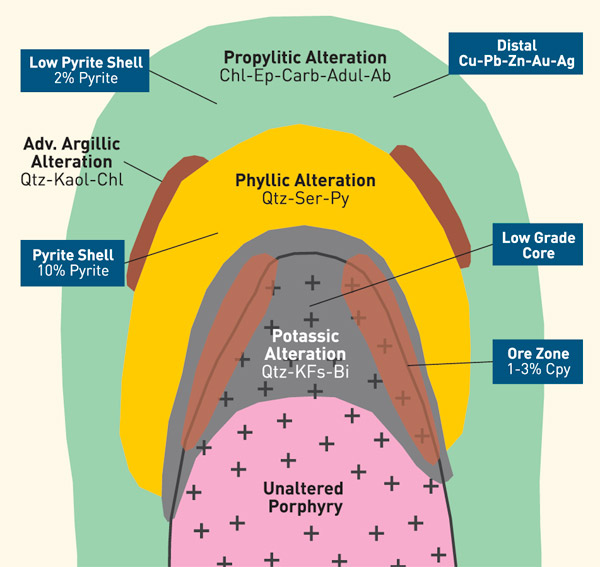
Porphyry deposits are a type of magmatic deposit that are economically important sources of copper, molybdenum, and gold, as well as other metals. They are named after the texture of the rocks that host the mineralization, which consists of large crystals, or phenocrysts, embedded in a finer-grained matrix, or groundmass.
Porphyry deposits are formed by the intrusion of magmas into the Earth’s crust, which can create large, deep-seated magma chambers. As these chambers cool and solidify, hydrothermal fluids are released, which can carry metals and other elements. These fluids migrate through fractures and other permeable structures in the surrounding rock, and can precipitate mineralization as they cool and interact with the host rocks.
Porphyry deposits are typically large and low-grade, with mineralization occurring over broad areas. They can also be polymetallic, meaning that they contain multiple metals of economic interest. Some of the world’s largest copper and gold mines are porphyry deposits, including the Bingham Canyon mine in Utah, USA, and the Grasberg mine in Indonesia.
Skarn Deposits
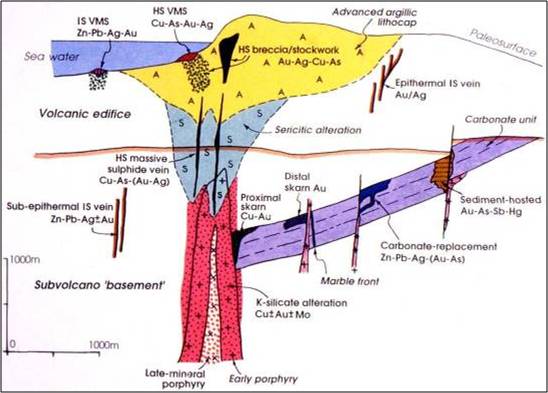
Skarn deposits are formed when hydrothermal fluids interact with carbonate-rich rocks, such as limestone or marble, resulting in the replacement of the original minerals by a variety of minerals, including those of economic interest. Skarns can host a wide range of metallic minerals, including copper, gold, silver, lead, zinc, tungsten, and molybdenum.
The formation of skarn deposits typically involves the following process:
- Intrusion of igneous rocks, which provide a heat and fluid source.
- Interaction of the igneous rocks with carbonate-rich sedimentary rocks, leading to the replacement of the carbonate minerals with new minerals.
- Deposition of economic minerals within the skarn.
Skarn deposits are often associated with porphyry deposits, as both are typically formed by the same hydrothermal system. Examples of skarn deposits include the Antamina deposit in Peru and the Mt. Skukum deposit in Canada.
Pegmatite Deposits

Pegmatite deposits are a type of magmatic deposit that are composed of unusually large crystals or masses of minerals that are commonly formed in the final stages of the crystallization of a magma. Pegmatites are generally coarse-grained and often contain rare or unusual minerals, making them of interest to mineral collectors and occasionally of economic interest. Some of the minerals commonly found in pegmatites include feldspar, mica, quartz, tourmaline, topaz, and beryl.
Pegmatites are typically found in association with granite, and they are commonly emplaced along the margins of granite plutons or within the plutons themselves. They can also occur as dikes or veins that cut across other rocks. The formation of pegmatites is thought to be related to the slow cooling of the magma and the consequent growth of large crystals, as well as to the presence of water and other volatile elements in the magma. Because of their unusual mineralogy and large crystal size, pegmatites can sometimes be important sources of industrial minerals, gemstones, and rare metals.
Kimberlite Deposits
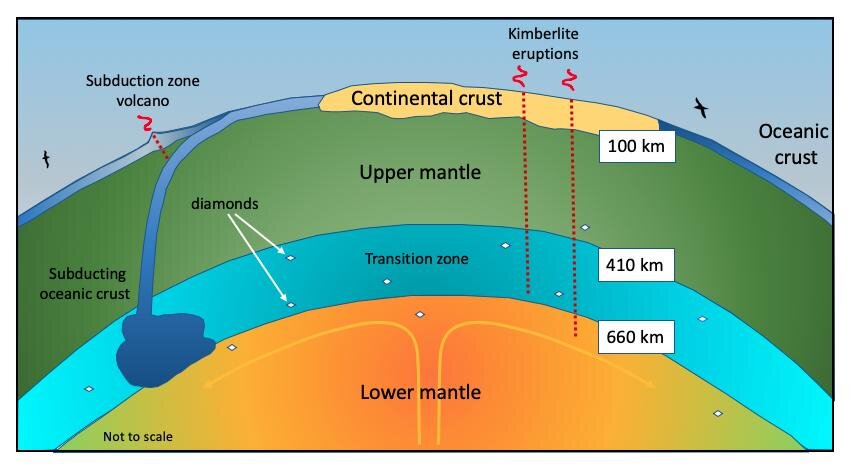
Kimberlite is a type of rock that is known for containing diamonds. Kimberlite is named after the town of Kimberley in South Africa, where the first diamonds found in kimberlite were discovered. Kimberlite is a type of volcanic rock that is formed from magma that rises from the Earth’s mantle and cools relatively quickly, preserving many of the mantle’s characteristics. Kimberlite pipes are the most important source of diamonds in the world. The diamonds in kimberlite pipes are thought to have originated deep in the Earth’s mantle and were brought to the surface by volcanic activity. Other minerals found in kimberlite include olivine, pyroxene, and garnet.
Carbonatite Deposits

arbonatite deposits are another type of magmatic deposit that are relatively rare but can be economically important. These deposits are characterized by their high concentrations of rare earth elements (REE), which are used in a variety of high-tech applications, such as electronics, magnets, and batteries.
Carbonatites are igneous rocks that are composed primarily of carbonate minerals, such as calcite and dolomite, as well as other minerals, such as apatite, magnetite, and phlogopite. They are believed to form from carbonatitic magma that originates deep within the mantle and rises to the surface, either directly or through the process of assimilation, where it cools and solidifies.
The Bayan Obo deposit in China is one of the largest carbonatite deposits in the world and is a major source of REEs. Other notable carbonatite deposits include the Palabora complex in South Africa, the Mount Weld deposit in Australia, and the Mountain Pass deposit in the United States.
Formation processes and mineralogy
Magmatic deposits form from the cooling and crystallization of magma, which can lead to the concentration of certain minerals into economic deposits. The mineralogy of magmatic deposits depends on the composition of the original magma and the conditions under which it cooled and crystallized.
The minerals commonly associated with magmatic deposits include sulfides, oxides, and silicates of metals such as copper, nickel, platinum, palladium, gold, and silver. These metals tend to be more concentrated in the denser and heavier minerals, which sink to the bottom of the magma chamber during the cooling and solidification process.
The mineralogy of magmatic deposits can also be influenced by the presence of volatile elements such as sulfur, chlorine, and fluorine, which can cause the formation of minerals such as apatite, magnetite, and fluorite. In addition, the cooling and solidification of magma can lead to the formation of minerals such as feldspar, mica, and quartz, which can sometimes be economically valuable.
Examples of notable magmatic deposits
There are many notable magmatic deposits around the world. Here are a few examples:
- Norilsk-Talnakh, Russia: This deposit is one of the largest sources of nickel and palladium in the world. It is located in the Siberian Traps, which are part of a large igneous province that was formed during the Permian-Triassic extinction event.
- Bushveld Complex, South Africa: This layered mafic intrusion is one of the world’s largest sources of platinum and chromium. The deposit is about 2 billion years old and covers an area of about 66,000 square kilometers.
- Sudbury Basin, Canada: This basin is one of the largest impact structures on Earth and contains a massive magmatic deposit that is rich in nickel, copper, and platinum group metals. The deposit was formed by a meteorite impact about 1.8 billion years ago.
- Palabora, South Africa: This deposit is one of the world’s largest sources of copper and contains significant amounts of gold and silver. It is located in a large carbonatite complex that was formed about 2 billion years ago.
- Stillwater Complex, USA: This layered mafic intrusion in Montana is a major source of platinum group metals and contains significant amounts of chromium and copper. The deposit is about 2.7 billion years old and covers an area of about 2,600 square kilometers.
These deposits are just a few examples of the many magmatic deposits that have been discovered around the world.


























